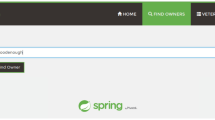Abstract
Due to the scarcity of resources, testing of each module is not possible for large projects. Thus, calculation of fault prone modules can be used for better resource utilization. A proposed token metric and the available object oriented metrics for forecasting the fault prone modules of an open source project has been proposed. The results from both set of metrics are compared to assess the effectiveness of the planned approach. The results concluded that (1) the proposed metric can be utilized for the calculation of fault prone modules with equivalent accuracy as in the case of object oriented metrics; (2) the token metric and object oriented metrics show opposite trends of results in precision and recall; (3) the proposed metric is much better for projects involving high risks.







Similar content being viewed by others
References
Jiang et al (2007) “Fault Prediction Using Early Lifecycle Data” ISSRE. In: 18th IEEE Symposium on Software Reliability Engineering, pp 237–246
Marshima MR, Teo NHI, Yusop NSM and Mohamad NS (2011) “Fault prediction model for web application using genetic algorithm”. In: International conference on computer and software Modeling (IPCSIT), vol 14
Jin C, Jin S, Ye J (2012) Artificial neural network-based metric selection for software fault-prone prediction model. IET Softw Inst Eng Technol 6(6):479–487
Tamanna et al (2011) Efficiency metrics. BVICAM’s Int J Inf Technol (BIJIT) 3(2):377–381 (issue 6)
Singh VB et al (2012) Open source software reliability growth model by considering change-point. International Journal of Information Technology (IJIT) 4(1):405 (issue 7)
Sandhu PS, Brar AS, Goel R, Kaur J (2011) “A model for early prediction of faults in software systems”. In: Computer and (ICCAE), vol 4, 2nd International Conference, pp 281–285
Singh Y, Kaur A, Malhotra R (2010) Prediction of fault-prone software modules using statistical and machine learning methods. Int J of Comput Appl (IJCA) 1(22):8–15
Kaur I, Kapoor N (2016) “Token-Based approach for cross project prediction of fault prone modules”. In: International Conference on Computational Techniques in Information and Communication Technologies (ICCTICT), pp 514–520
Mizuno O, Ikami S, Nakaichi S, Kikuno T (2007) Spam filter based approach for finding fault-prone software modules. Proc. Int, Workshop Mining Software Repositories
Bokhari et al (2010) A Comparative Study of Software Requirement Tools for Secure Software Development. BVICAM’s Int J Inf Technol (BIJIT) 2(2):207–216 (issue 4)
Jiang Y, Cukic B and Menzies T (2008) “Cost curve evaluation of fault prediction models”. In: Proceedings of 19th international symposium on software reliability engineering, USA, pp 197–206
Yu L (2012) “Using Negative Binomial Regression Analysis to Predict Software Faults: A Study of Apache Ant”. In: International journal of information technology and computer science (IJITCS), vol 8. MECS, pp 63–70
Pighin M, Marzona A (2013) Fault persistency and fault prediction in optimization of software release. Int J Inf Technol Comput Sci (IJITCS), MECS 7:15–23
V.R. Basili, L. Briand and W.L. Melo, “A validation of object-oriented design metrics as quality indicators”, in Technical Report, Univ. of Maryland, April 1995.
Aman H (2012) “An Empirical analysis of the impact of comment statements on fault-proneness of small-size module”. In: Software engineering conference (APSEC), 19th IEEE Asia Pacific Conference, vol 1, pp 362–367
Mizuno O, Hata H (2010) “An Empirical Comparison of Fault-prone Module Detection Approaches: Complexity Metrics and Text Feature Metrics”. In: 34th Annual IEEE Computer Software and Applications Conference, Seoul, pp 248–249
Mizuno O and Kikuno T (2007) “Training on errors experiment to detect fault-prone software modules by spam filter”. In: Proc. Of the 6th joint meeting of the European Software Engineering Conference and the ACM SIGSOFT Symposium on the Foundations of Software Engineering (ESEC-FSE), pp 405–414
Chidamber SR, Kemerer CF (1994) A metrics suite for object oriented design. IEEE Trans Softw Eng 20(6):476–493
Bishnu PS, Bhattacharjee V (2012) “Software fault prediction using quad tree-based k-means clustering algorithm. In: IEEE Transactions Knowledge Data Engineering 24(6)
Kumar G et al (2014) Optimization of Component based software engineering model using neural network. BVICAM’s Int J Inf Technol (BIJIT) 6(2):405–414 (issue 12)
GitHub. Available: https://github.com/
Jureczko M and Madeyski L (2010), “Towards identifying software project clusters with regard to defect prediction”. In: PROMISE, 6th international conference on predictive models in software engineering (2010), Available: http://promisedata.org
Author information
Authors and Affiliations
Corresponding author
Rights and permissions
About this article
Cite this article
Kaur, I., Narula, G.S. & Jain, V. Differential analysis of token metric and object oriented metrics for fault prediction. Int. j. inf. tecnol. 9, 93–100 (2017). https://doi.org/10.1007/s41870-017-0004-0
Published:
Issue Date:
DOI: https://doi.org/10.1007/s41870-017-0004-0




